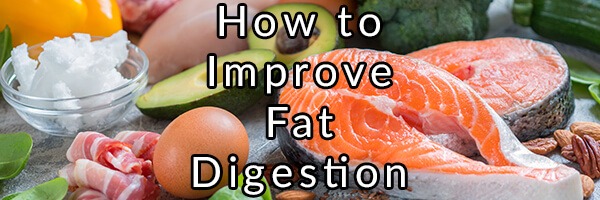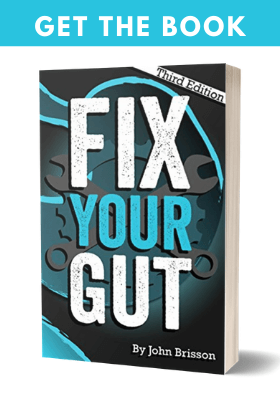Fat digestion and assimilation are essential for overall health. Many of my clients with upper gut dysbiosis have issues digesting fat, causing bile reflux and pyloric sphincter insufficiency. Ketogenic diets that are high in fat are a recent fad, and many people are discovering that no matter what they do, their digestive systems cannot become “fat adapted.” Jason and I have both blogged about how large amounts of MCT oil taken in the diet can cause diarrhea in Diarrhea From MCT Oil – Why Having “Disaster Pants” Is Not as Funny as It Sounds and How Ingesting MCT Oil Could Be Making You Ill and How to Limit It. There are many various reasons a person may have issues digesting fat ranging from dysbiosis, liver inflammation, pancreatic insufficiency, gallstones, to sphincter of Oddi dysfunction. So how can you improve fat digestion to improve your digestive health?
Fat is a macronutrient that is an essential source of energy for most living organisms. There are many different types of fatty acids, and some more than others are needed in different ratios for proper health. Saturated pastured animal fats, medium-chain triglycerides (lauric, caprylic, capric), oleic acid, and omega-three fatty acids (DHA and EPA) are needed in higher ratios for people ingesting the standard American diet, which is comprised more of omega-six fatty acids (which are needed by the body in moderation for production of endocannabinoids and phospholipids). Fat is stored as adipose tissue as a way of storing metabolic energy for long periods of time and used when needed to maintain ketosis during periods of prolonged fasting. Fats are also used by the body to regulate inflammation, cellular membrane structure, vision (DHA is very highly concentrated in the retina), digestion of fat-soluble vitamins, nervous system function, production of mediators, brain structure and function, and regulation of gene expression. So how do we make sure we break down and assimilate fat properly to better our health?1
So How Do We Digest the Fat That Is in Our Meals?
Fat digestion requires the function of many various organs and microbes working in tandem for it to occur. Any kink along the pathway of fat digestion can cause it not to be appropriately assimilated and cause fat to be dumped into the stool, and improper amounts of bile either be produced or utilized. If you are having lipid digestive issues, your stool will either look yellow (from undigested lipids concentrating in the stool) or very oily. You might get urgent diarrhea from eating a high-fat meal from bile not being reabsorbed properly. Finally, you may become constipated, and your stool might become dry and light brown or clay-colored from not producing enough bile. These stool changes are warning signs of inadequate bile production and utilization and fat digestion and assimilation issues.2
So how is fat digested and assimilated by the body?3 4 5
- Food that contains fat enters the stomach.
- Soluble fats like some medium-chain triglycerides (caprylic acid) are soluble in the stomach and absorbed immediately.
- The liver begins to synthesize bile salts from cholesterol, stored in the gallbladder for future use or directly into the duodenum when the hormone cholecystokinin (CCK) is produced (mainly in people where their gallbladder was removed).
- Insoluble fats like oleic acid are released into the duodenum through the digestive process. The hormone prosecretin is produced by the S cells in the duodenum and activated into secretin by stomach chyme entering the duodenum.
- Secretin triggers the liver to produce bile and the pancreas to produce sodium bicarbonate to neutralize the high pH of stomach chyme and increase pancreatic lipase and amylase functionality. The hormone CCK is produced by the duodenal enteroendocrine cells, while the stomach cyme enters the duodenum as well.
- Bile salts are formed in the liver. The hepatocytes metabolize cholesterol into cholic acid and chenodeoxycholic acid, which are conjugated with the amino acids glycine and taurine to form bile salts. Bilirubin is conjugated with glucuronic acid making it water-soluble, and is released into the bile to be eliminated by the gastrointestinal system. Bilirubin attaches itself to our stool, and very little is reabsorbed later, unlike bile. Colonic bacterial metabolize bilirubin in the stool, which is what makes our stool brown. Finally, bile is alkaline, which helps further neutralize stomach chyme and hinder dysbiosis.
- CCK causes bile salts to release into the duodenum (mainly from gallbladder contractions and the relaxation of the sphincter of Oddi) to start the emulsification of fats. CCK also later triggers the pancreas to release pancreatic juice that contains digestive enzymes and bicarbonate through relaxation of the sphincter of Oddi.
- Fats break down into mixed micelles.
- Lipase is released by the pancreas, and micelles are further broken down into free fatty acids and glycerides.
- The free fatty acids and glycerides are absorbed through the intestinal mucosa and are reconverted to triglycerides. The triglycerides aggregate with cholesterol and apolipoproteins to form chylomicrons, VLDL, HLDL. The byproducts enter the lymphatic system and then into the bloodstream, where they are used by the body for fuel, reesterfied and stored in adipose tissue, or are processed further by the liver by endocytosis.
- Bile salts are actively reabsorbed toward the end of the ileum back into hepatic recirculation. Some of our gut bacteria deconjugate bile acids back to lipid-soluble bile acids, which are passively reabsorbed. Bacteria deconjugate bile to protect themselves from its antimicrobial effects for survival. Finally, our gut bacteria convert some of the primary bile salts to secondary conjugated bile salts, improving fat digestion and assimilation.
- Excess fat, if any, is eliminated through the stool.
The body performs many different processes that must work like a well-oiled machine to digest and assimilate fat properly. If there is any issue during the fat digestion process, the body compensates for a time, but eventually, you will start suffering from digestive issues. So, what are the many different causes of fat malabsorption?
What Causes Poor Fat Digestion?
There are various causes of poor fat digestion, and they range from:6 7 8 9 10 11
- Upper gut dysbiosis. For example, overgrowth of the Gram-negative bacteria Prevotella, which can deconjugate bile, has been shown to cause bile acid malabsorption, diarrhea, yellow and greasy stools, hindered fat assimilation, and cause liver, gallbladder, and pancreatic inflammation. Parasites, bacterial biofilm, and yeast can block ducts and cause biliary sludge or gallstones to develop.
- Sphincter of Oddi dysfunction
- Diarrhea
- Diet can also cause poor fat digestion. Incorrectly following high-fat diets like ketogenic diets. The standard American diet, for example, which is very high in fat and carbohydrates, strain the liver by making it produce excessive bile for increased fat digestion and the excess carbohydrates leading to dysbiosis in the upper gut.
- Pancreatic insufficiency
- Bile production insufficiency
- Gallstones blocking bile from being appropriately released into the duodenum
- Pancreatitis
- Liver and gall bladder inflammation
- Cirrhosis of the liver
- SIBO (small intestinal bacterial overgrowth)
- Hypochlorhydria (low stomach acid production or elevated pH stomach chyme)
- Liver and gallbladder congestion (bile not being appropriately released, stagnant bile)
- Rapid dumping syndrome (mainly occurs from having a cholecystectomy, or known as gallbladder removal surgery)
- Bile acid malabsorption
- Gastric bypass surgery
- Viral gastroenteritis (Norovirus requires bile to propagate, so the body reduces production and release to hinder the virus; if this is occurring, your stool should become light brown or pale)
- Liver, gallbladder, pancreatic, or intestinal cancer
- Structural or birth defects in the biliary system
- Biliary or pancreatic duct strictures (from intestinal surgeries or birth defects)
- Sclerosing cholangitis (inflammation of the bile ducts)
- Cysts within the bile ducts (mainly caused by dysbiosis)
- Liver fibrosis
- Cystic fibrosis (people with cystic fibrosis tend to suffer from increased biliary sludge and more acidic bile)
- Hepatitis
- Medications like cholestyramine that bind bile
What Are the Symptoms of Poor Fat Digestion? Bile Reflux, Gastritis, and More!
Fat digestion and assimilation problems can manifest themselves as various digestive issues and health problems. You might notice that you get diarrhea after eating high-fat meals. Some people might look at their stool after staining and it can appear to be yellow, pale, or greasy. You may notice some right shoulder pain after eating a high-fat meal. Some people might suffer from chronic gastritis, and severe bile reflux. All of these are symptoms of lipid digestion issues.12 13
During digestion, sodium bicarbonate and digestive enzymes are released by the pancreas, and bile by the liver/gallbladder are released into the duodenum, mixing with duodenal chyme (our food that is partially digested from the stomach). Duodenal chyme, bile, gallbladder contents, and pancreatic secretions form a solution in our duodenum that further digests our food. When this solution gets into the stomach, it can cause gastritis, and then, if it continues upward into the esophagus, bile reflux. Your pyloric sphincter opens (wide at first when food is leaving the stomach, but the opening is supposed to get smaller as the amount of chyme in the stomach reduces from digestion, it does not open and constantly close to allow food in like the lower esophageal sphincter) to allow food contents to enter the duodenum from the stomach and can become weakened over time like the LES. If there is enough excessive pressure and the pyloric sphincter weakens and does not restrict properly, duodenal fluid reflux occurs into the stomach, known as bile reflux.14 15
It is normal to have minimal amounts of duodenal fluid in the stomach during digestion from the pyloric sphincter opening and closing and the equalization of pressure. However, frequent and prolonged exposure to the duodenal fluid damge the stomach lining and the cells of our stomach (gastric mucosa erythema, thickened gastric folds and mucosa, and erosions), creating excessive inflammation known as gastritis. If your LES is weakened, the duodenal fluid can reflux into the esophagus (bile reflux), causing significant inflammation (our stomach tissue can handle some of the alkaline duodenal fluid our esophagus cannot, bile reflux might be one of the leading causes of Barrett’s esophagus.) from a mix of digestive enzymes, pepsin, bile, and maybe endotoxins if you have dysbiosis. Bile reflux symptoms include heartburn, chronic gastritis, nausea, vomiting a greenish-yellow fluid (bile), sour alkaline taste in the mouth, fat digestion issues, Barrett’s esophagus, and LERD or GERD symptoms. Causes of bile reflux are many and include upper gut dysbiosis, SIBO (small intestine bacterial overgrowth), poor fat digestion and assimilation, chronic PPI use, lack of a gallbladder, poor stomach emptying timing (gastroparesis), constipation, and excessive improper microbe fermentation (bloating).16 17
There are many different ways to diagnose bile reflux. An endoscopy may also be performed to get an idea of esophageal damage and the general function of your pyloric sphincter, lower esophageal sphincter, upper esophageal sphincter, duodenum, and stomach. A flexible wire with a camera positioned at the end of the wire is swallowed during an endoscopy procedure. The camera takes pictures down the esophagus, stomach, sphincter, and duodenum. Traditional endoscopies are known to have issues associated with the procedure, including potential injury or death from sedation, increased risk of aspiration, and increased risk of infections from improperly sterilized (autoclaved) scopes. Endoscopes should only be performed when needed to determine your health issues and not be a front-line diagnostic method. One of the best assessments utilized in the diagnosing of bile reflux is an esophageal PH monitoring test. A flexible catheter with a pH monitor at the end is placed through the nose down into the esophagus for at least twenty four hours. A 48-hour dual-sensor pH catheter monitoring test (one pharyngeal probe and one esophageal probe) that can measure both acid and nonacid reflux (bile or silent reflux) events is instrumental in establishing a bile reflux diagnosis. Finally, the Bilitec monitoring system (which can be done at the same time as the pH test) was developed years ago to identify changes in the color of esophageal reflux. Because bile has a specific color range, this photo-colorimetric device can help determine the presence and duration of bile reflux into the esophagus.18 19
Reduction in bile production and biliary sludge (slow or improper bile release) can cause your stool to appear to be light brown or clay-colored from lack of bilirubin being deposited into the stool through bile. Reduction in bile production and biliary sludge can also cause fat malabsorption, and the stools may appear to be greasy or yellow. Most people with clay color or light brown stools suffer from constipation. Their stool may also break apart, be difficult to pass, appear dry from improper fat digestion, suffer from increased gastrointestinal transit time, and dysbiosis from lack of bile. However, people with yellow or greasy stool tend to suffer from diarrhea triggered by fat malabsorption and bile acids entering the large intestine, which stimulates increased water secretion into the stool, intestinal motility, and inflammation.20 21 22 23
Clay-colored stools can occur from a lack of bile being released by the liver or gallbladder and can be a sign of excess gallstones blocking the bile ducts and causing lower amounts of bile being released if you have right shoulder pain, liver pain or gastritis, abdominal pain, and if severe, elevated bilirubin or jaundice. Biliary sludge can cause problems for the MMC (migrating motor complex), causing random biliary dumping. Improper random bile dumping causes diarrhea, pain, bile acid malabsorption, clay-colored or yellow stools, and sphincter of Oddi dysfunction. Medications that bind bile like cholestyramine can also cause clay-colored schools and improper fat assimilation, increased binding and elimination of thyroid hormones (may lead to or worsen hypothyroidism), and reduction in cholesterol synthesis by the liver. Dysbiosis might occur from an improper production or release of bile which, causes either upper gut overgrowth, SIBO, or SIYO (small intestinal yeast overgrowth). Many people who suffer from improper bile production and release suffer from dysbiosis that would normally be controlled by bile. The dysbiosis can cause bloating and make their digestion worse.24 25 26 27
Some people with poor gallbladder function, gastrointestinal surgery, cholecystectomy, dysbiosis (bile deconjugation from bacteria), celiac disease, Crohn’s disease (ileal inflammation), ileal resection, overproduction of bile, might have diarrhea and yellow, greasy stools from bile acid malabsorption. Bile acids are produced in the liver for fat digestion and are stored in the gallbladder for future use. Bile acids during digestion are reabsorbed in the small intestine’s terminal ileum and are recycled through the liver. These bile acids are then stored again in the gallbladder for future use. In people with upper gut digestive issues, bile acids may not be reabsorbed properly, deconjugated by dysbiosis, or too much bile is produced, causing an excessive amount of bile acids traveling further into the large intestine. When bile salts make it into the large intestine, they stimulate extra water secretion and intestinal motility creating chronic diarrhea and abdominal cramping. Severe bile acid malabsorption can trigger rapid dumping syndrome (severe diarrhea, thirty minutes to a couple of hours after eating) if the person consumes a high-fat meal and is suffering from fat digestion issues.28 29 30 31
A lack of bile generally causes clay-colored stools and constipation, where too much bile or bile acid malabsorption mainly causes yellow and greasy stools and diarrhea. Most people with fat digestion issues also suffer from abdominal pain, cramping, right shoulder deferred pain, gastritis, decrease in sex hormone production, increase or decrease in thyroid hormone elimination, elevated or decreased serum cholesterol, elevated or decreased serum triglycerides, pancreatic, liver, or gallbladder inflammation, duct inflammation, narrowing, blockage, biliary sludge, gallstones, and dysbiosis. If you are suffering from fat digestion issues, what can be done to improve its digestion and assimilation?32 33 34 35
What Can You Do to Stop Bile Reflux and Improve Fat Digestion and Assimilation?
People who suffer from fat digestive and assimilation issues either have issues with bile production or biliary release timing that lead to their issues. The cause of most biliary issues (including bile reflux and pyloric insufficiency) stems from dysbiosis, but this is not always the case. Abdominal surgery’s causing duct strictures, scarring, or abdominal adhesions can cause ill biliary timing.
If you are suffering from bile reflux, reducing upper gut dysbiosis or SIBO if you are suffering from it may reduce your symptoms. Decreasing your stomach pH through the use of betaine HCL may help improve your symptoms. Your doctor may prescribe stomach acid-reducing medications like proton pump inhibitors. Still, they generally do not improve bile reflux symptoms because the problem is not acidic stomach chyme but alkaline. Improving gastric emptying, eating smaller meals with less fat, supplementing with one to two capsules of activated charcoal to bind with bile three to four hours after meals, and eating only three meals daily during the daytime may improve your symptoms. If you are constipated, relieving it may improve bile reflux symptoms by improving your MMC and gastric emptying (ginger tea or supplementation can help) by decreasing overall intraabdominal pressure enhancing the integrity of the pyloric sphincter. Finally, supplementation of D-limonene and zinc carnosine may help protect the stomach and esophagus from bile reflux, increase gastric emptying, and reduce inflammation.
A lack of bile production will manifest itself as dry clay-colored or yellow stools, liver or gallbladder pain, and constipation as I have discussed above. If you have issues with a lack of bile production by the liver, taking certain supplements or ingesting certain foods that stimulate bile production or trigger CCK release can help. Supplementing with lipase digestive enzymes and bile acid factors (do not use if you suffer from gastritis or bile acid malabsorption diarrhea) may improve fat digestion from a lack of bile. A reduction in fat consumption in the diet might need to occur at first to help with sluggish bile. Still, later the ingestion of oleic acid (olive oil, olives, avocados) to help stimulate bile production and release might be important. Finally, stagnant bile, sphincter of Oddi dysfunction, or gallstones might reduce bile release into the duodenum causing fat digestion issues.
If your liver seems to be underperforming or your liver enzymes and tests seem to be elevated. It might be a good idea to take glutathione, d-limonene, siliphos, or calcium d-glucarate to see if you can improve liver function. Your liver produces all your bile, and you want it to be functioning correctly for optimal fat digestion.36 37
Methods to Remedy Sluggish Bile Production
- Artichoke – one with lunch and one with dinner.38
- D-limonene
- Urban moonshine bitters – 1/4 tsp mixed in a glass of lukewarm or warm filtered water with your largest meal.39 40
- Magnesium malate – one capsule with each meal. Take less magnesium if it causes you to have diarrhea.41
- If you are not sensitive to caffeine and choose to use it, one cup of coffee (I recommend the use of Bulletproof coffee beans and filtered water) daily can improve bile flow and digestion.42 43
- Consider the supplementation of bile acids. Do not supplement if you are suffering from stomach ulcers, gastritis, or bile acid diarrhea. If you supplement with bile acids, consider taking zinc carnosine or DGL to protect the stomach lining; bile can be irritating to the lining over time.
- Consider supplementing with the amino acids taurine and glycine, which are important in the production of bile. I would recommend 250-500 milligrams of taurine (do not use if you have a CBS mutation) daily with a meal and 1,000 milligrams of glycine before bed (glycine should improve your sleep, if it makes you more irritable or causes sleep trouble, discontinue; more than likely you have a BHMT mutation).44 45
- The use of castor oil packs might improve liver function, toxin reduction, and enhance release of bile by the liver and the gallbladder.
- Upon waking, consume a glass of warm filtered water mixed well with 1/8 teaspoon of organic cayenne pepper, the fresh juice of an organic lemon, and 1/8 teaspoon of Real Salt to optimize bile production before breakfast.
- If you are suffering from stagnant bile buildup or gallstones, investigate the work of Dr. Hula Clark.
- If you have a PEMT (Phosphatidylethanolamine N-methyltransferase) mutation, ingesting high choline foods like eggs or taking a sunflower derived choline supplement may help reduce gallstone formation and improve fat digestion.46
When too much bile is released into the digestive tract or when bile is deconjugated by dysbiosis, many people have bile acid diarrhea. If you have upper gut dysbiosis and are suffering from diarrhea, yellow or pale loose stools, bloating, intestinal inflammation and pain, you are probably dealing with bile deconjugation or bile acid malabsorption issues. Improper releasing of too much bile, known as bile dumping, can trigger diarrhea, anxiety, tachycardia, hypoglycemia, and poor fat digestion as well. If you are dealing with bile deconjugation, it is best to investigate (get a stool profile like GI Effects) if you are suffering from upper gut dysbiosis (Prevotella is one genus known to cause bile deconjugation) and, if so, reduce the dysbiosis. Ingestion of kombucha might be beneficial for people suffering from bile deconjugation because D-saccharic acid-1,4-lactone, which is found in the fermented beverage, inhibits dysbiotic bacteria produced increased beta-glucuronidase. Increased amounts of beta-glucuronidase in the gut deconjugates bilirubin leading to the formation of calcium billrubinate. Increased calcium bullrubinate causes biliary sludge, gallstones, and lipid digestive issues. Most people suffering from bile deconjugation or bile dumping should avoid the supplementation of bile acids because it might cause inflammation, diarrhea, and worsen digestive issues.47 48 49 50
Supplements and Recommendations to Improve Fat Digestion and Prevent Bile Acid Diarrhea
-
- Zinc carnosine – one or two capsules with each meal.
- Pancreatin – one or two with each meal that contains fat or protein. Discontinue if it causes gastritis.
- Pure Radiance vitamin C – one capsule with breakfast and one with lunch.51
- Kombucha
- Reduce upper gut dysbiosis if you are suffering from it.
- Follow a diet that is lower in fat that requires the use of bile for assimilation. Your diet should consist of leaner cuts of meat (chicken and turkey breast, for example) and seafood (flounder or cod (white fish), for example), organic vegetables, lower fructose organic fruits (like berries, lemons, limes, kiwi, clementine, grapefruit, honeydew, and cantaloupe), bone broth (remove the fat), and healthy carbohydrates like honey, rice, sweet potatoes, plantains, taro, tapioca, sorghum, and potatoes. Your main sources of fat should be from leaner cuts of meat, white fish, and Brain Octane Oil in small amounts with meals (¼ teaspoon per meal). You should ingest small amounts of other healthy fats if possible depending on your tolerance, like avocados (maybe ¼ to ½ every so often), extra virgin olive oil, butter, and ghee (maybe one teaspoon or two of these daily).
Conclusion
I have coached many people suffering from fat digestion issues, whether it is bile reflux, sluggish bile, gallstones, or bile acid diarrhea. Most of the problems stem from gut dysbiosis, standard diet, stagnant bile, and poor liver function. In the toxin burdened world we live in, when ingesting high fat, high carb diets, our liver and pancreas can become taxed, and fat digestion and assimilation can become compromised, making us ill. Hopefully, the above advice and protocols can help improve fat digestion, restore liver function, and get the bile flowing again to improve your gut ailments. Fat ingestion is essential for our health. Make sure you can digest it to live a healthier life.
- http://lpi.oregonstate.edu/mic/other-nutrients/essential-fatty-acids ↩
- Smith, Margaret, Morton, Dion. The Digestive System: Systems of the Body Series, Churchill Livingstone, November 18, 2011. ↩
- Smith, Margaret, Morton, Dion. The Digestive System: Systems of the Body Series, Churchill Livingstone, November 18, 2011. ↩
- Patton, Kevin, Thibodeau, Gary, Douglas, Matthew. Essentials of Anatomy and Physiology, Mosby, March 16, 2011. ↩
- Enders, Giulia, Gut: The Inside Story Of Our Body’s Most Underrated Organ, Greystone Books, 2015. ↩
- Smith, Margaret, Morton, Dion. The Digestive System: Systems of the Body Series, Churchill Livingstone, November 18, 2011 ↩
- Patton, Kevin, Thibodeau, Gary, Douglas, Matthew. Essentials of Anatomy and Physiology, Mosby, March 16, 2011. ↩
- Enders, Giulia, Gut: The Inside Story Of Our Body’s Most Underrated Organ, Greystone Books, 2015. ↩
- https://www.wired.com/2016/09/secret-breakthrough-fighting-norovirus-human-bile/ ↩
- Brook, Itzhak, Anaerobic Infections: Diagnosis and Management, CRC Press, 2007 ↩
- Porter, Rob. The Merck Manual, Merck, 2011. ↩
- Smith, Margaret, Morton, Dion. The Digestive System: Systems of the Body Series, Churchill Livingstone, November 18, 2011. ↩
- Patton, Kevin, Thibodeau, Gary, Douglas, Matthew. Essentials of Anatomy and Physiology, Mosby, March 16, 2011. ↩
- https://www.cghjournal.org/article/S1542-3565%2818%2930222-2/abstract ↩
- https://www.ncbi.nlm.nih.gov/pmc/articles/PMC3745208/ ↩
- https://www.cghjournal.org/article/S1542-3565%2818%2930222-2/abstract ↩
- https://www.ncbi.nlm.nih.gov/pmc/articles/PMC3745208/ ↩
- https://www.cghjournal.org/article/S1542-3565%2818%2930222-2/abstract ↩
- https://www.ncbi.nlm.nih.gov/pmc/articles/PMC3745208/ ↩
- Smith, Margaret, Morton, Dion. The Digestive System: Systems of the Body Series, Churchill Livingstone, November 18, 2011. ↩
- Patton, Kevin, Thibodeau, Gary, Douglas, Matthew. Essentials of Anatomy and Physiology, Mosby, March 16, 2011. ↩
- Enders, Giulia, Gut: The Inside Story Of Our Body’s Most Underrated Organ, Greystone Books, 2015. ↩
- Porter, Rob. The Merck Manual, Merck, 2011. ↩
- Smith, Margaret, Morton, Dion. The Digestive System: Systems of the Body Series, Churchill Livingstone, November 18, 2011. ↩
- Patton, Kevin, Thibodeau, Gary, Douglas, Matthew. Essentials of Anatomy and Physiology, Mosby, March 16, 2011. ↩
- Enders, Giulia, Gut: The Inside Story Of Our Body’s Most Underrated Organ, Greystone Books, 2015. ↩
- Porter, Rob. The Merck Manual, Merck, 2011. ↩
- Smith, Margaret, Morton, Dion. The Digestive System: Systems of the Body Series, Churchill Livingstone, November 18, 2011. ↩
- Patton, Kevin, Thibodeau, Gary, Douglas, Matthew. Essentials of Anatomy and Physiology, Mosby, March 16, 2011. ↩
- Enders, Giulia, Gut: The Inside Story Of Our Body’s Most Underrated Organ, Greystone Books, 2015. ↩
- Porter, Rob. The Merck Manual, Merck, 2011. ↩
- Smith, Margaret, Morton, Dion. The Digestive System: Systems of the Body Series, Churchill Livingstone, November 18, 2011. ↩
- Patton, Kevin, Thibodeau, Gary, Douglas, Matthew. Essentials of Anatomy and Physiology, Mosby, March 16, 2011. ↩
- Enders, Giulia, Gut: The Inside Story Of Our Body’s Most Underrated Organ, Greystone Books, 2015. ↩
- Porter, Rob. The Merck Manual, Merck, 2011. ↩
- https://www.selfhacked.com/blog/milk-thistle/ ↩
- https://www.drlam.com/blog/calcium-d-glucarate/16797/ ↩
- https://www.selfhacked.com/blog/artichoke-extract-13-health-benefits/ ↩
- https://www.ncbi.nlm.nih.gov/pmc/articles/PMC4446506/ ↩
- http://www.itmonline.org/arts/chlorogenic.htm ↩
- https://drcarolyndean.com/2010/08/take-your-gall-bladder-back/ ↩
- https://www.ncbi.nlm.nih.gov/pmc/articles/PMC4446506/ ↩
- http://www.itmonline.org/arts/chlorogenic.htm ↩
- https://www.ncbi.nlm.nih.gov/pubmed/8915345 ↩
- https://www.springer.com/cda/content/document/cda_downloaddocument/9780854048465-c1.pdf?SGWID=0-0-45-616901-p173817041 ↩
- Lynch, Ben. Dirty Genes, HarperOne, 2018 ↩
- Smith, Margaret, Morton, Dion. The Digestive System: Systems of the Body Series, Churchill Livingstone, November 18, 2011. ↩
- Patton, Kevin, Thibodeau, Gary, Douglas, Matthew. Essentials of Anatomy and Physiology, Mosby, March 16, 2011. ↩
- Enders, Giulia, Gut: The Inside Story Of Our Body’s Most Underrated Organ, Greystone Books, 2015. ↩
- Porter, Rob. The Merck Manual, Merck, 2011. ↩
- https://www.ncbi.nlm.nih.gov/pubmed/2375883 ↩







Great article. I’ve had weird/bad reactions to any liver support supplement, especially Bile Acid Supplements. I’ve had my gallbladder removed, so taking extra bile seems like a no brain right? It just makes me feel worse. A huge symptom is like, pressure behind my eyes? And just all over feel terrible.
I think there’s some type of overgrowth going on. I’ve read clostridium can actually be “germinated” by bile acids. I’ve also read E. Coli can de-conjugate bile. And now I’m learning it might be Prevotella.
I think I’ll just have to dump more money and get the GI stool profile. Ubiome hasn’t been as helpful as I hoped.
Probiotics is also helpful to all who have a digestive problems.By the way Thank you for sharing this nice article.